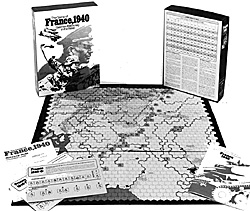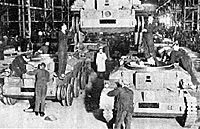 France, 1940, is a failure as a simulation and a problem as a game. This is unfortunate, because the campaign is one of the most interesting in modern history, and rather obviously a lot of work went into the game design. When I first received my review copy of
France, 1940 I was enormously impressed. There were many new, and apparently well thought out concepts. The game made a qualitative distinction between armor and infantry, by allowing mechanized forces an extra move after combat. The air force rules seemed very well designed. The game looked good; but when I began to play it, I saw very quickly that
it had problems.
France, 1940, is a failure as a simulation and a problem as a game. This is unfortunate, because the campaign is one of the most interesting in modern history, and rather obviously a lot of work went into the game design. When I first received my review copy of
France, 1940 I was enormously impressed. There were many new, and apparently well thought out concepts. The game made a qualitative distinction between armor and infantry, by allowing mechanized forces an extra move after combat. The air force rules seemed very well designed. The game looked good; but when I began to play it, I saw very quickly that
it had problems.
I will discuss below precisely how the simulation fails, but first it is interesting to look at why it was so. I think it was because the designers simply couldn't cope with the limits of simulation as I described them in Conflict #3. They tried to design a game in which the Allies, knowing what we know now, would be unable to prevent German victory similar to the actual campaign of France, 1940. They succeeded, certainly. Given the historical orders of battle, there is no strategy for the Allies that will prevent a good German player from winning. (I am aware that in the Jan-Feb '73 General Richard Wagner presented an ingenious method for giving the Allies a slim chance by withdrawing all their forces from the frontiers, hiding their air forces and the British units, and erecting a trench-line in front of Paris.
Even this fails, and it is obviously not intended as something the Allies might seriously have considered in 1940.) Since there are very good reasons for believing that the Allies could have prevented the Gemman romp -- these will be discussed below -- France, 1940 fails as a simulation; and certainly anything that one-sided fails as a game.
COULD FRANCE HAVE BEEN DEFENDED IN 1940?
The designers of France, 1940 obviously don't think so, and Mr. Dunnigan states in his designer's notes that given players of equal ability the Germans can't lose. This is not quite the same thing as saying that the war wouldn't have turned out differently if, as Dunnigan puts it, "the allies hadn't been as stupid as they originally were," but his other remarks make it clear that he believes so.
With all respect for Mr. Dunnigan, some of the foremost military historians of our time disagree. (These include not only the British strategists B. H. Liddell Hart and J.F.C. Fuller, but also the Germans, including Manstein, Guderian, and von Mellenthin.) Moreover, it wouldn't have required a German defeat to change the course of history. If the Germans had merely been contained, Italy wouldn't have entered the war, the U.S. would probably have never been involved, Russia might have attacked Germany, and in any event there would have been strong pressure for a negotiated peace. Hitler's ouster would probably have been a requirement of that peace, and the German Army would undoubtedly have sent him to exile: there was plenty of precendent in the Army's treatment of their Kaiser, to whom they had far more real devotion. I must disagree with Mr. Dunnigan. In the real world of 1940, the Germans could have lost. It's only in his game that they can't.
Let's examine a possible defense of France as proposed by one of the foremost military analysts of our time.
LIDDELL HART'S STRATEGY FOR THE DEFENSE OF FRANCE
Even given the forces actually engaged in Spring, 1940, the German Blitzkrieg might have been stopped; at least, Liddell Hart believed so, not only at the time, but until he died. His commentary is summarized in the Memoirs:
- "The collapse of the West in 1940 was a world-shaking disaster which changed the course of history for the worse. Yet never was a great disaster more easily preventable.
 At right: British cruiser tanks on the assembly line. Had priority been given to these AFVs before or shortly after the start of World War II, the BEF could have been equipped with two or three full armored divisions by May, 1940.
At right: British cruiser tanks on the assembly line. Had priority been given to these AFVs before or shortly after the start of World War II, the BEF could have been equipped with two or three full armored divisions by May, 1940.
"The panzer forces' thrust could have been stopped long before reaching the Channel by a concentrated counterstroke with similar forces. But the French, though having more and better tanks than the enemy, had strung them out in small packets in the 1918 way. The one British armored division available was not dispatched to France until after the German offensive was launched, and thus arrived too late for the first, and decisive, phase.
The thrust could have been stopped earlier, on the Meuse, if the French had not rushed into Belgium leaving their hinge so weak, or had moved reserves there sooner. For the French Command had not only regarded the Ardennes as impassable to tanks but reckoned that any attack on the Meuse would be a set-piece assault on the 1918 style, and could not be delivered before the ninth day of the offensive . . . thus allowing the French Command ample time to bring up reserves. But Guderian's Panzer Corps, reaching the river early on May 13, stormed the crossings that same afternoon (the fourth day) . . .
" . . . this Blitzkrieg pace was only possible because the Allied leaders had not grasped the new technique, and so did not know how to counter it. The thrust could have been stopped before it even reached the Meuse if the approaches had been well covered with minefields. It could have been stopped even if the mines were lacking -- by the simple expedient of felling trees along the forest roads that led to the Meuse. The loss of time in clearing them would have been fatal to the German chances. For the issue turned on the time-factor."
A GAME TRY AT THE LIDDELL HART STRATEGY
Let us assume that there is no "idiocy factor" operating on the Allied side, but that the Allied player must fight with the units and rules of France, 1940. First, he won't be able to halt the rapid German advance in the Ardennes, there being no provision in the rules for either minefields or felling trees. He may attempt to fight in the Ardennes, but he will be outflanked in Belgium, and eventually forced to retire to his frontier.
Suppose, though, he does this, and without serious losses. He forms a defense line, and all his armor is concentrated behind his line as reserves. He is ready to deliver against a German Panzer attack "a concentrated counterstroke with similar forces."
The German infantry moves up. Every other Allied unit in the line is attacked by two German 7-6 Corps units plus 12 factos of German armor -- 4:1 odds. Even without German air support the French will be lucky merely to retreat; they'll probably lose units. No WW I slogging here! A hole opens in the Allied line, and the German armor moves into it.
AHA! cries the Allied player. He pushes forward his entire armored strength, six divisions, plus the two flanking infantry corps remaining in the line, all attacking a mere two German Panzer divisions which have, supposedly, just taken part in an attack on three Allied divisions.
The Allies will have 12 factors of infantry and 21 factors of armor to fling against these almost surrounded German divisions. The Germans won't be cut off, of course, since theyll be supplied through connecting units; but surely they're in trouble?
No. There is precisely zero probability that the Germans will lose a unit. In fact, there is a probability of one -- i.e., certainty -- that the Allied line will be broken, the only question being just how badly it will be cracked open. A "BR" (both retreat) result opens the French line even further as a result of this attack by 12 divisions against two Panzer divisions! Using the Allied air power doesn't change the result significantly; the German player still can't lose a unit!
There is obviously something wrong here.
More BEF Variant
Back to Conflict Number 5 Table of Contents
Back to Conflict List of Issues
Back to MagWeb Master Magazine List
© Copyright 1998 by Dana Lombardy
This article appears in MagWeb (Magazine Web) on the Internet World Wide Web.
Other military history articles and gaming articles are available at http://www.magweb.com